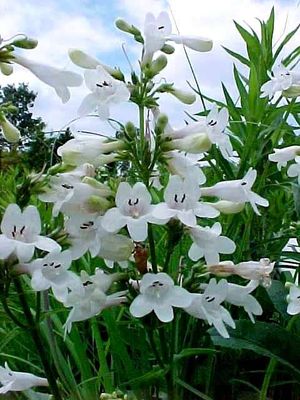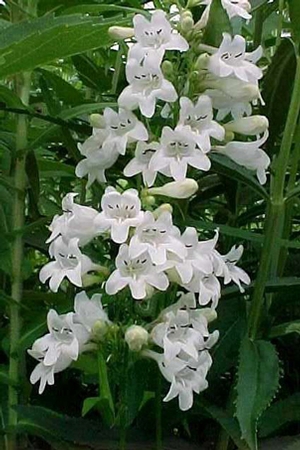Penstemon digitalis
Common: beardtonguePenstemon digitalis LP50 - 50 per flat
- Height: 3'-4'
- Spread: 18"
- Spacing: 12"
- Hardiness Zone(s): 3-8


Penstemon digitalis LP50 - 50 per flat

In early summer, white or light-pink-tinted, tubular 1" flowers on branching, hollow stalks rise above a basal rosette of lustrous dark green leaves. Drought tolerant, tough as nails, and deer resistant. The tubular flowers make an excellent landing pad for bees, butterflies and hummingbirds alike!
Prefers average to moist, well-drained soil in full to partial sun. Penstemon digitalis is drought tolerant but grows poorly in heavy clay soils. Great for wild and perennial gardens, xeriscaping as well as naturalized areas.
Penstemon digitalis, or beardtongue, blooms in early summer with white or light-pink-tinted, tubular 1" flowers on branching, hollow stalks rise above a basal rosette of lustrous dark green leaves. Growing 3-5’ tall, beardtongue is drought tolerant, tough as nails, and deer resistant. The vigor in which this plant grows makes it a strong competitor against weeds in a native planting and the tubular flowers make an excellent landing pad for bees, butterflies and hummingbirds alike!
Penstemon digitalis can be found as far northeast as Maine and as far southwest as Texas with the highest density of populations found along the Mississippi River Basin. This leads experts to believe that this is where the plant originated and it spread slowly over time to other locations. Beardtongue prefers average to moist, well-drained soil in full to partial sun and is found in low, moist areas such as prairies or open woodlands. Penstemon digitalis is drought tolerant but grows poorly in heavy clay soils. Too heavy of soils and winter moisture can cause crown rot in some Penstemon. One of its best features, beardtongue will tolerate dry shade, as long as it isn’t deep shade.
Perfect for wild and perennial gardens, xeriscaping as well as naturalized areas, beardtongue supports dozens of native bees and pollinators including long-tongued bees as well as Halictid bees, moths, butterflies, and hummingbirds. The foliage supports at least three different larval stages of moths and the foliage is generally unattractive to mammalian herbivory. When placed in the right location, this native will happily self-sow and create wondrous drifts of soft white in early summer.